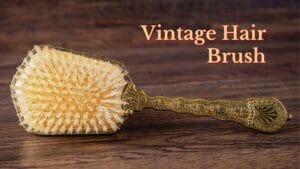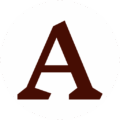$500-$1,000. That’s what collectors are recently paying for a vintage hairbrush at auctions and online sales. Not a typo. Not a set. One hairbrush.
Vintage hairbrushes are a hot collectible in antique markets these days! Because of their ornate bodies and natural bristles, collectors highly seek these vanity pieces, paying insane prices! But spotting a REAL VALUABLE hairbrush can be a bit tricky!
So let me help you here. By the time you finish reading this, you’ll know exactly how to spot a valuable antique hairbrush and – more importantly – what makes some worth serious money while others just a few bucks!
How Can You Spot Real Vintage Hairbrushes?
Hairbrushes have been around a lot longer than most people think. Ancient Egyptians used primitive combs and brushes, and the Romans had their grooming tools.
But the hairbrush as we know it today? That didn’t take off until 1777 when William Kent started the first commercial brush company in England. With time, each era brought changes to the shapes, designs, and materials. For example, early brushes were handmade.
Fun Fact: It took twelve craftsmen to make a single Kent brush by hand! That’s the real skill!
Then came the Industrial Revolution in the 1880s with machine-boring techniques, and the 1920s brought synthetic materials and Art Deco designs. So, to spot a real antique or vintage hairbrush, you need a keen understanding of all the key features!
Types of Hairbrushes
The first step to identifying a vintage hairbrush is to recognize its type. That’s right, hairbrushes come in different types for different purposes. Here are the most common types you’ll come across:
- Vanity or Dresser Set Brushes: These are the most common brushes. They were designed as part of matching sets with combs, hand mirrors, and sometimes powder jars or nail buffers. Vanity brushes were essential during the Victorian, Edwardian, and Art déco periods.
- Military Brushes: These have no handles – they’re oval or rectangular brushes that fit in a man’s palm. Often sold in pairs, sometimes with a leather travel case. The design is practical, but the materials could be luxurious, like ebony wood or sterling silver backs.
- Combination Brushes: As the name hints, these were clever space-savers with combs that slide into the back or handle. These brushes were popular in the early to mid-20th century as travel items.
- Early Modern Styles (Post-1950s): These mostly feature evolving plastics. You’ll find vented brushes for blow-drying, round styling brushes, and detanglers. Most are mass-produced, but early examples from brands like Fuller Brush or unique atomic-age designs in Lucite can be collectible!
Materials
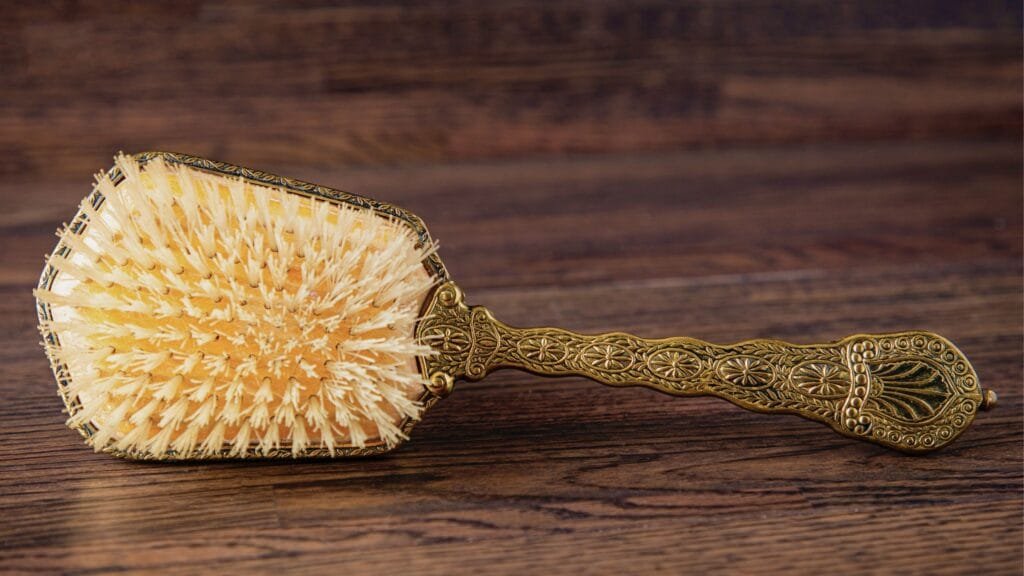
The material used in old brushes is a key indicator of their age and value. And both the handle and bristle materials are your biggest clues. Let’s see how you can spot a brush by its materials.
Handle Materials
- Sterling Silver: Sterling is the premium choice for vanity items, including brushes. They’re heavy, beautifully crafted, and often come with complete hallmark systems that help you date them precisely.
- Ivory: You can identify ivory handles by their rare and distinctive creamy-white look. Also, check for “Schreger lines” – that unique grain pattern of intersecting arcs. It feels heavy, smooth, and cool.
- Bone: Bone gets mistaken for ivory but is lighter and more porous. You can often see tiny dots or channels where blood vessels were. It doesn’t have ivory’s cross-hatched grain.
- “French Ivory” & Celluloid: This early plastic from the 1890s-1940s is made to look like ivory. You can spot a celluloid brush by the lack of natural ivory grain. These pieces can be quite valuable, especially those of Art Deco style.
- Bakelite & Catalin: These are heavier, early thermosetting plastics from the 1920s-40s. Bakelite comes in dark colors, while Catalin can be bright and sometimes translucent. Rub vigorously until warm, and it may smell like formaldehyde. Running under hot water amplifies this smell.
- Lucite is clear acrylic plastic from the 1940s-50s. Often features embedded objects, such as glitter or flowers (sometimes referred to as “prison art,” although not always accurately so). Decorated Lucite brushes have a decent fan base.
- Wood: Early brushes used fine wood varieties, like rosewood, ebony, or satinwood, sometimes with silver or mother-of-pearl inlays. The wood type and quality indicate age and quality.
Bristle Materials
- Natural Boar Bristles: Boar bristles were the high-quality standard for centuries. They’re stiff but flexible, often yellowish or off-white, and set in tufts drilled directly into the wooden or bone base. In silver-backed brushes, this wooden base gets covered by silver repoussé work.
- Horse hair: These are tough and rigid and keep their strength over time. These bristles are quite thin and have their natural color.
- Nylon Bristles: These came from DuPont in the late 1930s and spread after WWII. They’re typically bright white or uniform in color with a “plasticky” look and feel. The ends are often perfectly uniform and rounded, unlike natural bristles.
Makers’ Marks & More
Maker’s marks are like fingerprints – they tell you exactly who made your brush and often when.
You will find manufacturers’ marks on the handles or the back. In case of Sterling, silver-plated, or gold-plated examples, you’ll find metal purity marks (hallmarks). These marks are almost always found on authentic pieces.
Here are some most renowned hairbrush makers and their markings:
| Maker/Mark Type | What to Look For |
| G.B. Kent & Sons (English) | Often stamped “Kent of London,” “Pure Bristle,” “G.B. KENT & SONS,” or with their Royal Warrant symbol (a coat of arms) |
| Mason Pearson (English) | The iconic “Mason Pearson England” logo on the handle |
| Tiffany & Co. (American) | Clearly marked “Tiffany & Co.” along with “Sterling” or “.925.” |
| Gorham Mfg. Co. (American) | A lion, an anchor, and the letter “G.” |
| Unger Bros. (American) | Look for the intertwined “UB” monogram and “Sterling 925 Fine.” |
| English Hallmarks | The Lion Passant – sterling silver/The City Mark (e.g., anchor for Birmingham, leopard head for London) – region/The Date Letter |
Note: These markings may appear different from the original marks found on the pieces, as these are explained based on previously sold items.
Dating Signs
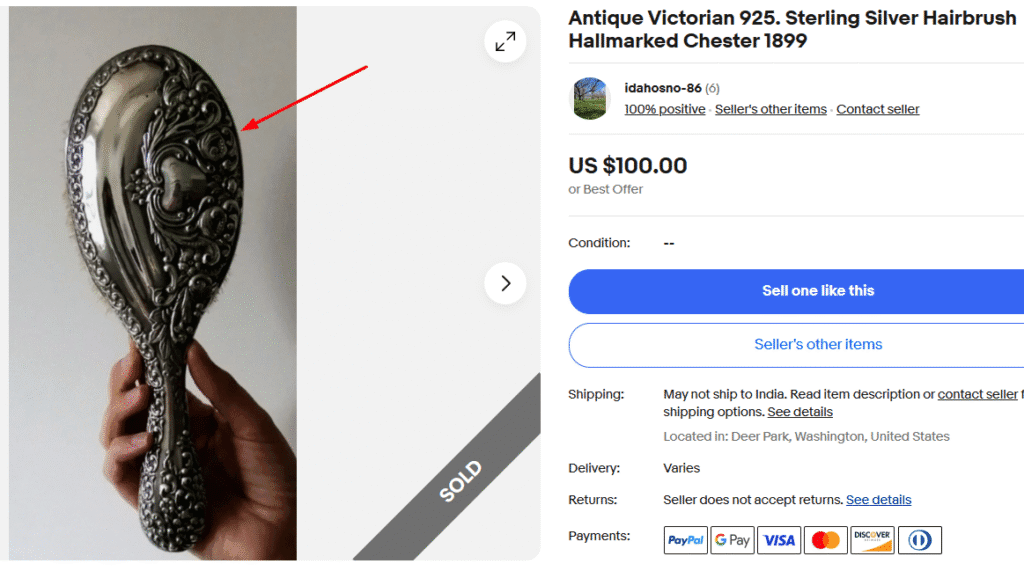
Tracing the exact age of vintage brushes isn’t always easy, but there are certain features that speak of their age. Here are some easy-to-spot clues you can look for:
Construction Clues
- Hand-stitched Bristles (pre-1885): Multiple craftsmen worked on each brush. You can often see slight irregularities that prove hand construction.
- Machine-bored Holes (post-1885): More uniform hole patterns were seen on the base after the invention of the automatic boring machine.
- Synthetic elements (post-1920s): If an old hairbrush uses any plastic components, it usually means it’s a 1920s or later piece.
Design Styles
To date an antique hairbrush, you must identify its design style by its shape, motifs, and patterns. Here’s a quick breakdown for you:
- Victorian (1840-1900): Victorian hairbrushes are all about ornate, heavy, romantic designs. Look for flowers, scrolls, cherubs, and highly detailed repoussé (raised relief) work in silver – basically, everything that can impress.
- Art Nouveau (1890-1910): These pieces are popular for flowing, organic lines with those signature “whiplash” curves. You’ll find nature-inspired motifs like lilies, dragonflies, and elegant female figures with flowing hair everywhere. Unger Bros. is the classic American maker for this style.
- Art Deco (1920-1935): Art Deco brushes completely shifted to bold, geometric patterns, straight lines, sharp angles, and streamlined looks. New materials like Bakelite and chrome became popular alongside traditional silver.
- Mid-Century Modern (1945-1965): Mid-century pieces went simpler and often minimalist. Clear Lucite and colorful plastics dominated, with forms becoming more organic and abstract compared to Art Deco’s rigid geometry.
What Makes an Antique Hairbrush? (4 Key Factors)

Not every old brush is worth a lot of money. You can assess these key factors that work together to determine which vintage hairbrushes collectors will actually pay for.
Materials
As I said earlier, materials also play a huge role in deciding a brush’s value. Certain materials are more valuable than others, especially with their unique craftsmanship.
Some of the most valuable materials that can reach up to $500-$1,000+ are:
- Sterling silver with detailed engraving
- Ivory with intricate carving
- Whalebone with original markings
- Gold plating in perfect condition
Pieces made of silver plate, fine wood (ebony, walnut, etc.), early celluloid, and brass stand in the middle with average values of $80-$150.
Condition
Like every other antique, the value of antique hairbrushes largely depends on their condition. Nobody wants to pay big money for a brush that’s damaged, right? So, here’s what collectors appreciate:
- All bristles intact and secure
- No cracks or chips in handles
- Original finish preserved
- Minimal wear patterns
- All pieces present if it’s a set
A well-preserved vintage brush with minimum damage and all things intact can be worth 20-40% more than one in poor condition.
Complete Sets vs. Single Pieces
When it comes to vanity hairbrushes, completeness matters a lot! Full vanity hairbrush sets with a matching hand mirror, a hair comb (or more), and a clothes brush are where the big money lives. These pieces can fetch twice the value of single brushes (unless you’re looking at a SUPER RARE piece)!
A 5- or 6-piece set with additional items like powder jars, nail files, or buttonhooks can also be highly valuable! Besides, additions like original fitted cases, boxes, or pouches can add up to 25-50% to a brush’s value.
Rarity & Collectibility
The rarer a vintage hairbrush, the more valuable it is. Here are the key signs of rarity you must look for on your old brush:
- Rare Materials: Beyond the basic silver/ivory, materials like tortoiseshell, mother-of-pearl, jade, coral, amber, and unusual metal combinations like niello work and Damascus steel can be super rare and valuable!
- Unusual Designs on Handle & Back: Brushes featuring unique, unconventional designs on the back, such as mythical creatures and sculptural elements, are rather rare today. Figurial handle brushes are another example of rarity!
- Limited Edition: Vintage brushes made for a limited special line or a limited period are always super collectible. These include royal commissions, exhibition pieces, artist collaborations, and special orders.
- Manufacturing Anomalies: Production errors, prototypes, samples, and regional specialties can create unexpected value for a vintage brush!
7 Examples of Rare Vintage Hairbrushes Worth Money
Now that you know how to spot the real deal, here are some examples of rare vintage hairbrushes that have sold for hundreds (some even more)!
1. Tiffany & Co. New York Sterling Repousse Brush
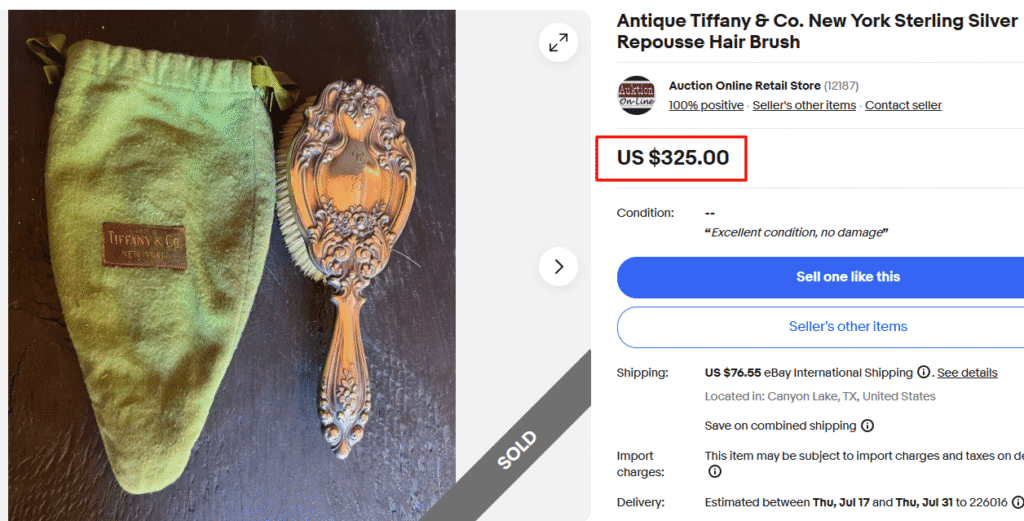
A vintage vanity hairbrush from Tiffany beats everything! Bearing the coveted Tiffany & Co. mark, this is easily one of the most desirable collectible hairbrushes you can find, featuring the 1920s Art Nouveau style’s inspiration in the metal scrollwork!
The elaborate repoussé floral design is totally Tiffany’s legendary artistry, which made it one of America’s the most premier luxury jewelers. This example comes with its original Tiffany pouch, which adds even more value!
2. 1920s Art Deco Birmingham Hair Brush Vanity Set
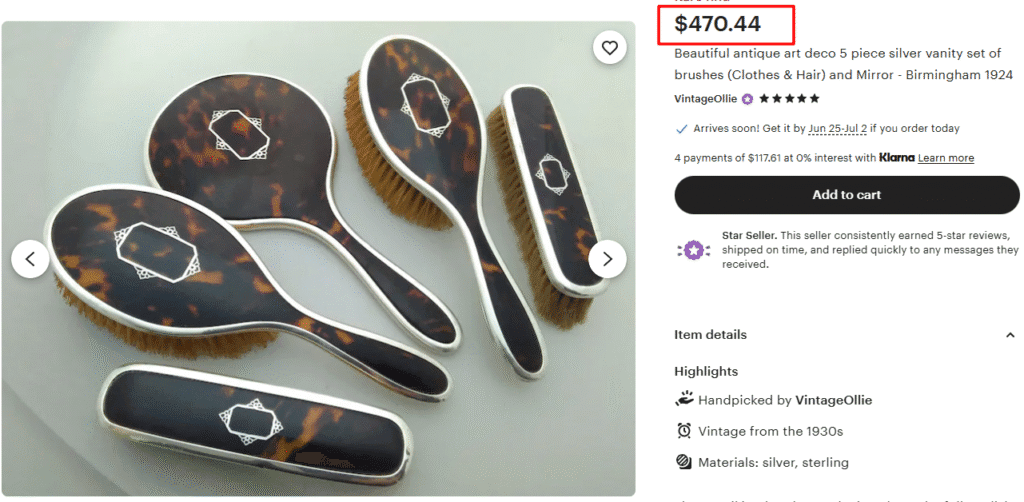
This is a magnificent, complete vanity set featuring a variety of vintage brushes and a hand mirror, all with a combination of sterling silver and mottled natural backs. Original Birmingham pieces are generally hallmarked, like this one, with Sterling marks and the ‘GWL&Co’ mark.
The elegant geometric silver inlays on all the pieces give you a glimpse of the Art Deco period. And the natural backs (probably tortoiseshell) make these pieces collectible! Complete matching sets from this era are quite hard to find; no wonder this one fetched over $470!
3. Gorham Sterling Repousse Hairbrush & Cloth Brush Set
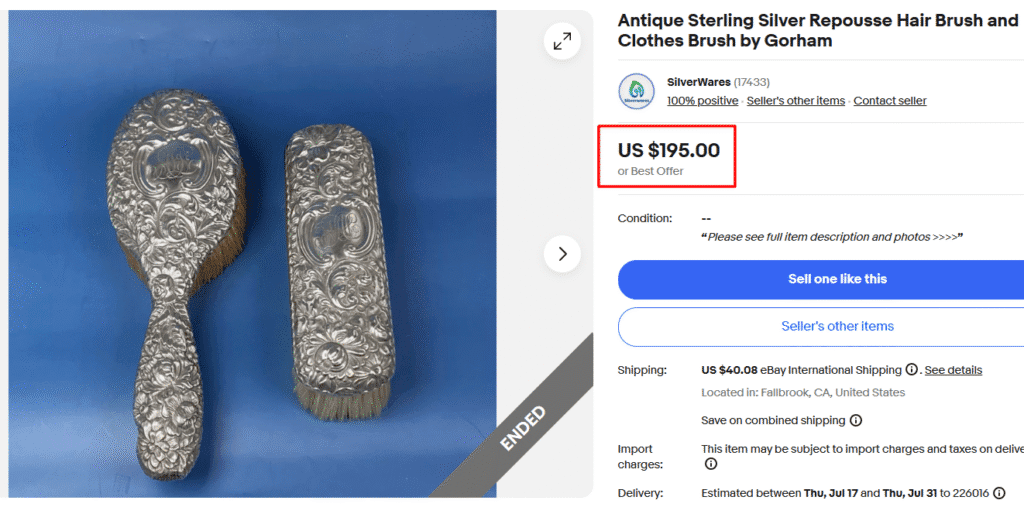
Gorham’s Sterling silver vanity sets are easily the most valuable ones! This example is a hair and cloth brush set featuring Gorham’s famous repousse technique (intricate floral patterns are hammered from the back to create raised relief designs).
Genuine Gorham silver brushes are always hallmarked, so you can easily verify them. The now-extinct metalwork technique, combined with precious metal like Sterling, is what makes these pieces highly sought-after today; I mean, you won’t find this design on today’s brushes or combs, right?
4. Antique Carved Wood Norwegian Boars Hair Brush

This is a gorgeous hairbrush pair featuring traditional Norwegian woodcarving at its finest. Those geometric rosette and crosshatch patterns carved into the wooden backs are classic Scandinavian folk art that required serious skill to pull off.
This set is likely over 100 years old and still in beautiful shape, making it worth the price tag of $110! Besides, this set has the original natural boar bristles, which were top-of-the-line back then, and are highly collectible today!
5. Hand Painted Enameled Porcelain & Silver Hairbrush

This piece screams Victorian style! It features a detailed and life-like hand-painted enamel portrait of a Victorian lady surrounded by ornate silver scrollwork, typical of 1910s European vanity sets.
The painting, decorative metalwork, and fine enameling on this brush are a true example of the era’s obsession with romanticism! These portrait brushes were originally part of complete dresser sets – often wedding gifts or family heirlooms. Full sets can easily fetch $500-$800 or more!
6. Stanley Half-Round Nylon Bristles Hair Brush
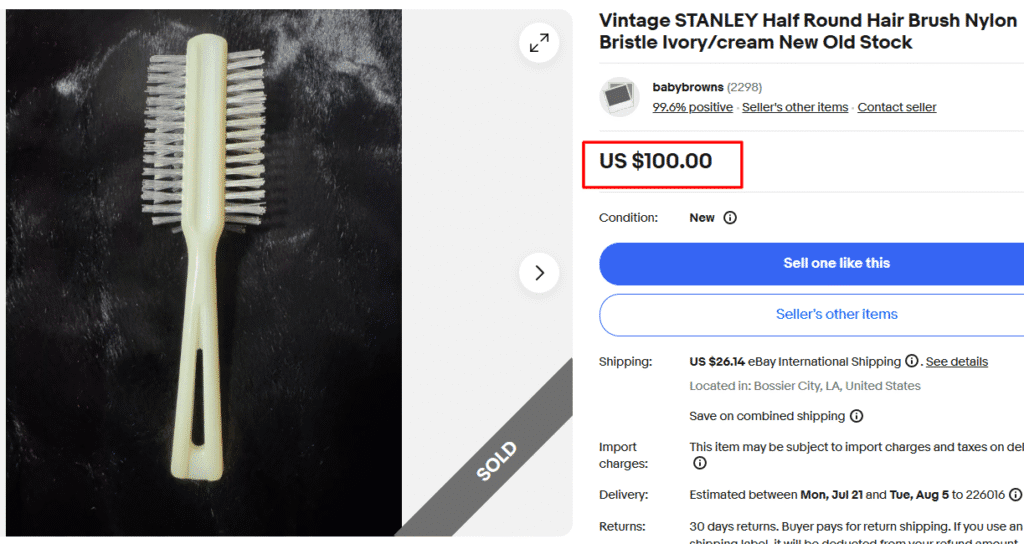
This Stanley brush, popular in the 1950s-60s, was a revolutionary piece for its time! It features the iconic half-round design with original nylon bristles, making it more of an offering gentler detangler than traditional boar bristles.
Also, this ivory/cream colored hairbrush marks the company’s transition to modern synthetic materials while maintaining the durability that it’s known for.
7. Victorian Medium-Soft Boar Bristle Hair Brush

This authentic Victorian brush is made of genuine boar bristles set in a rich wood handle and base. The elegant and original, clear wood grains indicate good preservation, making this vintage hairbrush quite exotic!
While antique wooden hairbrushes aren’t as valuable as Sterling pieces, these can still fetch a decent value of $30-$80+ if found in good condition, and especially with natural bristles, like boar!
Note: This article is intended for informational, educational, and entertainment purposes only. Some images are illustrative and may not represent actual brands, products, or related entities. All trademarks, product names, brand logos, packaging, and other intellectual property referenced remain the exclusive property of their respective owners. Any brand mentions or references are provided solely for descriptive and educational context and do not imply any formal or commercial association.

